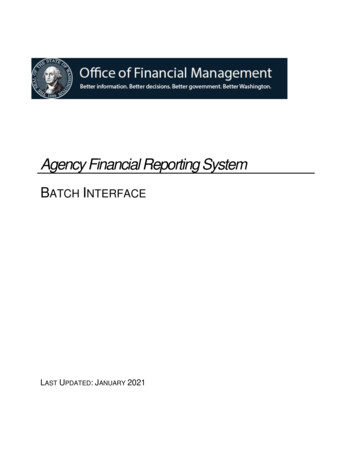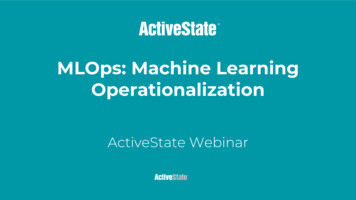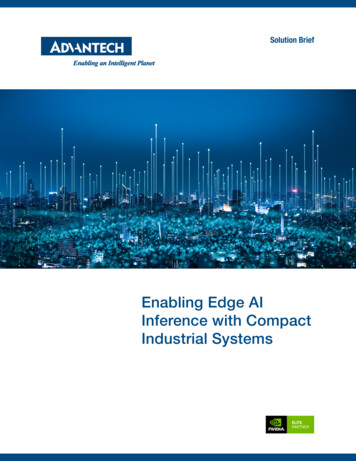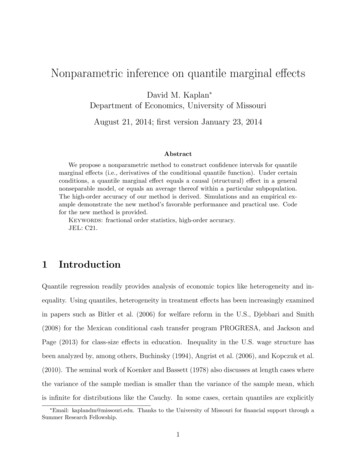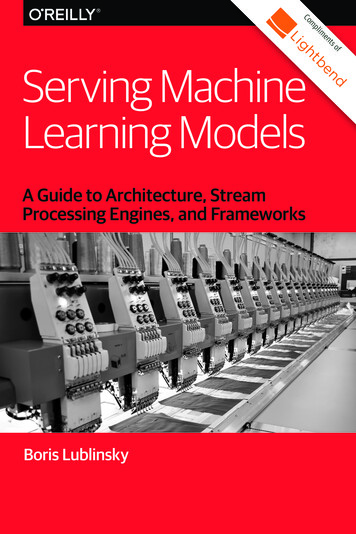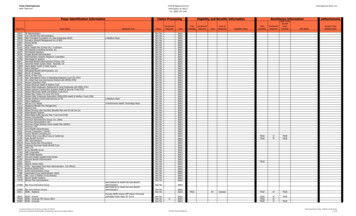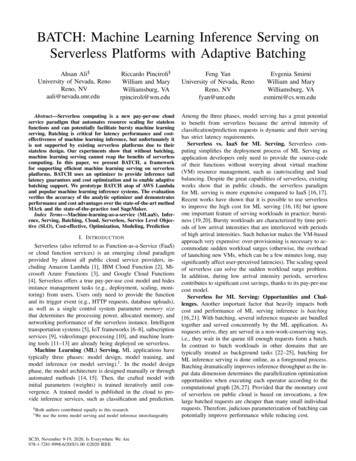
Transcription
BATCH: Machine Learning Inference Serving onServerless Platforms with Adaptive BatchingAhsan Ali§University of Nevada, RenoReno, NVaali@nevada.unr.eduRiccardo Pinciroli§William and MaryWilliamsburg, VArpinciroli@wm.eduAbstract—Serverless computing is a new pay-per-use cloudservice paradigm that automates resource scaling for statelessfunctions and can potentially facilitate bursty machine learningserving. Batching is critical for latency performance and costeffectiveness of machine learning inference, but unfortunately itis not supported by existing serverless platforms due to theirstateless design. Our experiments show that without batching,machine learning serving cannot reap the benefits of serverlesscomputing. In this paper, we present BATCH, a frameworkfor supporting efficient machine learning serving on serverlessplatforms. BATCH uses an optimizer to provide inference taillatency guarantees and cost optimization and to enable adaptivebatching support. We prototype BATCH atop of AWS Lambdaand popular machine learning inference systems. The evaluationverifies the accuracy of the analytic optimizer and demonstratesperformance and cost advantages over the state-of-the-art methodMArk and the state-of-the-practice tool SageMaker.Index Terms—Machine-learning-as-a-service (MLaaS), Inference, Serving, Batching, Cloud, Serverless, Service Level Objective (SLO), Cost-effective, Optimization, Modeling, PredictionI. I NTRODUCTIONServerless (also referred to as Function-as-a-Service (FaaS)or cloud function services) is an emerging cloud paradigmprovided by almost all public cloud service providers, including Amazon Lambda [1], IBM Cloud Function [2], Microsoft Azure Functions [3], and Google Cloud Functions[4]. Serverless offers a true pay-per-use cost model and hidesinstance management tasks (e.g., deployment, scaling, monitoring) from users. Users only need to provide the functionand its trigger event (e.g., HTTP requests, database uploads),as well as a single control system parameter memory sizethat determines the processing power, allocated memory, andnetworking performance of the serverless instance. Intelligenttransportation systems [5], IoT frameworks [6–8], subscriptionservices [9], video/image processing [10], and machine learning tools [11–13] are already being deployed on serverless.Machine Learning (ML) Serving. ML applications havetypically three phases: model design, model training, andmodel inference (or model serving).1 . In the model designphase, the model architecture is designed manually or throughautomated methods [14, 15]. Then, the crafted model withinitial parameters (weights) is trained iteratively until convergence. A trained model is published in the cloud to provide inference services, such as classification and prediction.§ Both1 Weauthors contributed equally to this research.use the terms model serving and model inference interchangeablySC20, November 9-19, 2020, Is Everywhere We Are978-1-7281-9998-6/20/ 31.00 2020 IEEEFeng YanUniversity of Nevada, RenoReno, NVfyan@unr.eduEvgenia SmirniWilliam and MaryWilliamsburg, VAesmirni@cs.wm.eduAmong the three phases, model serving has a great potentialto benefit from serverless because the arrival intensity ofclassification/prediction requests is dynamic and their servinghas strict latency requirements.Serverless vs. IaaS for ML Serving. Serverless computing simplifies the deployment process of ML Serving asapplication developers only need to provide the source-codeof their functions without worrying about virtual machine(VM) resource management, such as (auto)scaling and loadbalancing. Despite the great capabilities of serverless, existingworks show that in public clouds, the serverless paradigmfor ML serving is more expensive compared to IaaS [16, 17].Recent works have shown that it is possible to use serverlessto improve the high cost for ML serving [16, 18] but ignoreone important feature of serving workloads in practice: burstiness [19,20]. Bursty workloads are characterized by time periods of low arrival intensities that are interleaved with periodsof high arrival intensities. Such behavior makes the VM-basedapproach very expensive: over-provisioning is necessary to accommodate sudden workload surges (otherwise, the overheadof launching new VMs, which can be a few minutes long, maysignificantly affect user-perceived latencies). The scaling speedof serverless can solve the sudden workload surge problem.In addition, during low arrival intensity periods, serverlesscontributes to significant cost savings, thanks to its pay-per-usecost model.Serverless for ML Serving: Opportunities and Challenges. Another important factor that heavily impacts bothcost and performance of ML serving inference is batching[16,21]. With batching, several inference requests are bundledtogether and served concurrently by the ML application. Asrequests arrive, they are served in a non-work-conserving way,i.e., they wait in the queue till enough requests form a batch.In contrast to batch workloads in other domains that aretypically treated as background tasks [22–25], batching forML inference serving is done online, as a foreground process.Batching dramatically improves inference throughput as the input data dimension determines the parallelization optimizationopportunities when executing each operator according to thecomputational graph [26, 27]. Provided that the monetary costof serverless on public cloud is based on invocations, a fewlarge batched requests are cheaper than many small individualrequests. Therefore, judicious parameterization of batching canpotentially improve performance while reducing cost.
II. M OTIVATION AND C HALLENGESWe discuss the potential advantages of using serverless forML serving and summarize its open challenges.A. ML Serving Workload is BurstyWorkload burstiness is omnipresent in non-laboratory settings [32–35]. Past work has showed that if burstiness is notincorporated into performance models, the quality of theirprediction plummets [36, 37].Fig. 1(a) plots the arrival intensity of cars passing throughthe New York State (NYS) Thruway during three businessdays in the fourth quarter of 2018 [29]. This trace representsa typical workload of an image recognition application thatdetects the plate of vehicles that pass under a checkpoint2015Oct. 08Oct. 09Nov. 16105006:00 12:00 18:00timeArrival Intensity [r/s]Arrival Intensity [r/s]Due to the stateless property of serverless design, i.e.,no data (state) is kept between two invocations, batchingis not supported as a native feature within the serverlessparadigm. An additional challenge is that batching introducestwo configuration parameters: batch size (i.e., the maximumnumber of requests to form a batch) and timeout (i.e., themaximum time it allows to wait for requests to form the batch).These parameters need to be adjusted on the fly according tothe arrival intensity of inference requests to meet inferencelatency SLOs. The performance and cost effectiveness ofbatching depends strongly on the judicious choice of the aboveparameters. No single parameter choice can work optimally forall workload conditions.Our Contribution. Here, we address the above challengesby developing an autonomous framework named BATCH [28].The first key component of BATCH is a dispatching bufferthat enables batching support for ML serving on serverlessclouds. BATCH supports automated adaptive batching andits associated parameter tuning to provide tail latency performance guarantees and cost optimization while maintaininglow system overhead. We develop a lightweight profiler thatfeeds a performance optimizer. The performance optimizer isdriven by a new analytical methodology considers the salientcharacteristics of bursty workloads, serverless computing, andML serving to estimate inference latencies and monetary cost.We prototype BATCH atop of AWS Lambda and evaluate its effectiveness using different ML serving frameworks(TensorFlow Serving and MXNet Model Server) and imageclassification applications (MoBiNet, Inception-v4, ResNet18, ResNet-50, and ResNet-v2) driven both by synthetic andreal workloads [29,30]. Results show that the estimation accuracy of the analytical model is consistently high (average erroris lower than 9%) independent of the considered system configurations (i.e., framework, application, memory size, batchsize, and timeout). Controlling the configuration parameters onthe fly, BATCH outperforms SageMaker [31] (the state-of-thepractice), MArk [16] (the state-of-the-art), and vanilla Lambdafrom both cost and performance viewpoints. More importantly,BATCH supports a full serverless paradigm for online MLserving, enabling fully automated and efficient SLO-aware MLserving deployment on public clouds.(a) NYS Thruway150100500Feb. 14Feb. 15May 2506:00 12:00 18:00time(b) TwitterFig. 1: Real-world traces from [29] and [30].[18]. The three days have distinct arrival intensities that arenon-trivial to accurately predict. Distinct traffic peaks are alsoobserved in a Twitter trace [30] that represents a typical arrivalof tweets processed for sentiment analysis that has been usedfor ML serving elsewhere [16]. Fig. 1(b) shows the arrivalintensity of three distinct days in the first semester of 2017.Observation #1. ML inference application often have burstyarrivals. Burstiness must be incorporated into the design ofany framework for performance optimization.B. Why Serverless for ML ServingThere are two types of approaches to cope with suddenworkload surges: resource over-provisioning and autoscaling.For bursty workloads, resource over-provisioning is not costeffective as the difference between high and low intensitiescan be dramatic and lots of paid computing resource is leftidle for extensive periods.Autoscaling is the current industry solution: Amazon’sSageMaker [31] facilitates ML tasks and supports AWS autoscaling [38]. With SageMaker, users can define scalingmetrics such as when and how much to scale.We examine Sagemaker’s scaling in Fig. 2. Here, arrivalsare driven by the Twitter trace illustrated in Fig. 1(b) (May 25,2017) and the inference application is Inception-v4. The figureshows that SageMaker’s scaling is very slow, as it requiresseveral minutes before responding to an arrival intensity surge,which is not acceptable as requests’ performance during thisperiod suffers, see the latency results of Fig. 2(a). SageMakerbeing SLO-oblivious cannot ensure quality of service.Serverless is potentially a good solution for solving theresource allocation problem, thanks to its automated and swiftresource scaling capabilities. Take AWS’s serverless platformLambda (also referred in this paper as Vanilla Lambda) forexample: Fig. 2(b) demonstrates the number of instanceslaunched overtime, we can see that the number of instancesclosely follows the bursty arrival intensity shown in Fig. 1(b).SageMaker stays almost flat due to its long reaction window.Another advantage of serverless compared to IaaS (e.g.,SageMaker) is its true pay-per-use cost model as Lambdacharges based on the number of invocations, which canpotentially reduce cost, especially during time periods withfew arrival. Here, we use the term cost to refer to themonetary cost per request, i.e., total cost over the numberof executed requests. The total cost is calculated as in [39]
LambdaLambdaSagemaker1510007001400Time [min](a) Latency128096064020031400700Avg. Cost [ /r] (10-4)Concurrent fucntions1086420SagemakerInstance countLatency [sec]LambdaSagemaker0.70.350Time [min](b) Instance count(c) CostCLambda (S · M · I) · K1 I · K2 ,(1)where S is the length of the function call (referred as batchservice time here), M is the memory allocated for the function,I is the number of calls to the function that decreases whenrequests are batched together, K1 (i.e., 1.66667 · 10 5 /GB-s)is the cost of the memory, and K2 (i.e., 2 · 10 7 ) is the costof each call to the function. This is different from the AWSEC2 cost, i.e., CEC2 K · H, that only accounts for the costper hour of an instance (K) and the number of power-on hoursof the instance (H).Observation #2. Compared to IaaS solutions (autoscaling),serverless computing is very agile, which is critical for performance during time periods of bursty workload conditions.In addition, the quick scale down and pay-per-use cost modelcontributes to the cost-effectiveness of serverless.6LambdaMArk420060012001800Avg. Cost [ /r] (10-4)without considering the free tier (i.e., free invocations andcompute time available every month):Latency [sec]Fig. 2: Performance of inference using Inception-v4 deployed on SageMaker (with instance type c5.4xlarge) and Lambda. Thenumber of instances used by Sagemaker varies between 5 to 11 based on the workload intensity.0.5LambdaMArk0Time [sec](a) Latency(b) CostFig. 3: 95th percentile latency and cost for Inception-v4 duringunexpected workload surge with MArk and Lambda. Thevertical dashed line marks the workload surge.D. Serverless and Batching ConfigurationsOne important factor that existing work ignores is batching.By batching several requests together, the input dimension ofinference significantly increases, which provides great opportunities for parallelization. Batching results in more efficientinference since it enables a better exploitation of modernC. The State of the Arthardware [40]. In addition, as serverless charges users basedUsing serverless for ML serving has been explored in on the number of invocations, a few large batched requestsrecent works [16–18]. The above works conclude that using result in lower cost than many small individual ones.Batching introduces two tuning parameters: batch size andserverless for ML serving is too expensive compared to IaaStimeout[13, 16]. These two parameters need to be adjustedbased solutions. Our experimental results are consistent withbasedonthe request arrival intensity. Changing these twocurrent literature findings, e.g., in Fig. 2(c), Lambda’s cost isparametersalso affects the optimal memory size, the onlyhigher than SageMaker. To address the cost issue, MArk [16]parameterthatcontrols the performance and cost of serverlesshas introduced a hybrid approach of using both AWS EC2 andinpubliccloud,since the memory required to serve a batchserverless, where serverless is responsible for handling arrivalincreaseswiththebatch size. For example, the minimumbursts. MArk can dramatically improve the IaaS solution but isstill insufficient in the serverless setting. First, it uses machine memory required to serve a batch of size 1, when the inferencelearning to predict the arrival intensity, this is too expensive for application is ResNet-v2, is 1280 MB, while 1664 MB (i.e.,any practical use. Second, even though MArk is SLO-aware, 30% more) memory is required for processing a batch of sizeit needs an observation window for the decision of whether to 20. To demonstrate the above, we do sensitivity analysis byuse serverless or not, therefore it reacts to arrival bursts after a adjusting the batching parameters and memory size and showlag, which impacts tail latency. Fig. 3(a) shows this outcome. results in Fig. 4. Fig. 4 depicts the normalized (min-max)With serverless, there are no such reaction delays as scaling average request service time (blue line), request throughput(green line), and monetary cost (red line). In Fig. 4(a), theis automatic.Observation #3. While state-of-the-art systems employ a batch size varies from 1 to 20, the memory size is set to 3008hybrid approach of using serverless and IaaS for ML serving, it MB, and the timeout is assumed to be long enough (i.e., 1suffers from slow reaction time and consequently long latency hour) to allow the system to form a batch with maximumsize. Although cost reduces and throughput increases whentails.
Request Service TimeRequest ThroughputMonetary 1620Batch Size(a) Timeout 1 hr, Memory 3008 MB000.10.20.31.5Timeout [s](b) Batch Size 20, Memory 3008 MB22.53Memory Size [GB](c) Batch Size 5, Timeout 1 hrFig. 4: Effect of batch size, timeout, and memory size on average request service time, request throughput, and monetary costof ResNet-v2 deployed on AWS Lambda. Service time, throughput, and cost are normalized (min-max).Empirical MeasurementsEmpirical Measurementsbatch size increases, request processing times suffer as earlierof Arrival Processof Service Timesrequests need to wait until the entire batch is formed. Similar1a1bconsiderations may be drawn when timeout varies, see Fig.BATCHProfiler2a2b4(b). It is worth noting that for the considered configuration,ArrivalService Timethe timeout effect on the system performance decreases when3processModelit is longer than 0.2 seconds. Long timeouts allow reachingPerformanceBudgetSLOsOptimizer4bthe maximum batch size easier, especially if the batch size isMemory Size [MB]BatchSize4aTimeout [s]small. Fig. 4(c) depicts the system performance as a functionBatchDispatchingof the memory size, when the batch size is 5, and the timeout isBuffer56Serverlesslong enough to guarantee that all requests are collected (e.g., 1PlatformWorkloadhour). Here, monetary cost is not monotonous since it dependsFig. 5: Overview of BATCH.on both memory size and the batch service time, see Eq. (1). InFig. 4(c), both these parameters are varying at the same timegiven that the processing time decreases with more memory.Observation #4. The effectiveness of batching strongly de- arrival requests. There is no existing method that can optimizethe above parameters on-the-fly. We are motivated to developpends on its parameterization.an optimization methodology that can continuously tune theseE. Challenges of ML Serving on Serverlessparameters to provide SLO support.Lightweight: Given that the cost model of serverless is payDespite the great potential of using serverless for MLper-use,the aforementioned optimization methodology needsserving, there are several challenges that need to be addressedtobelightweight.Such requirement excludes learning orto enable efficient ML serving on serverless:simulationbasedapproaches.We are thus motivated to buildNo batching support: As shown in Section II-C, batchingtheoptimizationmethodologyusing analytical models.can drastically improve the performance [21] and monetary cost of ML serving. However, existing serverless platformsin public clouds do not support this important feature due toits stateless design, i.e., no data (state) can be stored betweentwo invocations. To solve this challenge, we extend the currentserverless design to allow for a dispatching buffer so thatrequests can form a batch before processing.SLO-oblivious: ML serving usually has strict latency SLOrequirements to provide good user experience. Past studieshave shown that if latency increases by 100 ms, revenue dropsby 1% [41]. Existing serverless platforms in public cloudsare SLO-oblivious and do not support user specified latencyrequirements. We are motivated to develop a performance optimizer that can support strict SLO guarantees and concurrentlyoptimize monetary cost.Adaptive parameter tuning: To support user defined SLOwhile minimizing monetary cost, memory size (the singleserverless parameter) and batching parameters need to bedynamically adjusted (optimized) according to the intensity ofIII. BATCH D ESIGNBATCH determines the best system configuration (i.e.,memory size, maximum batch size, and timeout) to meet userdefined SLOs while reducing the cost of processing requestson a serverless platform. The workflow of BATCH is shownin Fig. 5. Initially, BATCH feeds the Profiler with empiricalmeasurements of the workload arrival process 1a and servicetimes 1b . The Profiler uses the KPC-toolbox [42] to fit thesequence of arrivals into a stochastic process 2a and usessimple regression to capture the relationship between systemconfiguration and request service times 2b . Using as inputsthe fitted arrival process, request service times for differentsystem configurations, the monetary budget, and the userSLO, BATCH uses an analytic model implemented withinthe Performance Optimizer component to predict the distribution of latencies 3 and determines the optimal serverlessconfiguration to reach specific performance/cost goals while
complying with a published SLO. The optimal batch sizeand timeout are communicated to the Buffer 4a , while theoptimal memory size is allocated to the function deployed onthe serverless platform 4b . The Buffer uses the parametersprovided by the Performance Optimizer to group incomingrequests into batches 5 . Once the batch size is reached orthe timeout expires, the accumulated requests are sent fromthe Buffer to the serverless platform for processing 6 . Furtherdetails are provided for each component of BATCH below.A. ProfilerTo determine the workload arrival process, the Profilerobserves the inter-arrival times of incoming requests. BATCHuses the KPC-Toolbox [42] to fit the collected arrival trace intoa Markovian Arrival Process (MAP) [43], a class of processesthat can capture burstiness. To profile the inference time onthe serverless platform, the Profiler measures the time requiredto process batches of different sizes for certain amounts ofallocated memory. BATCH derives the batch service timemodel using multivariable polynomial regression [44] andassuming that inference times are deterministic. Past work hasshown that inference service times are deterministic [45], ourexperiments (see Section VI-B) confirm this.B. BufferSince serverless platforms do not automatically allow processing multiple requests in a single batch, BATCH implements a Buffer to batch together requests for serving. Theperformance optimizer determines the optimal batch size basedon the arrival process, service times, SLO, and budget. Theperformance optimizer also defines a timeout value that isused to avoid waiting too long for collecting enough requests.Therefore, a batch is sent to the serverless platform as soonas either the maximum number (batch size) of requests iscollected or timeout expires.C. Performance OptimizerThe Performance Optimizer is the core component ofBATCH. It uses the arrival process and service time (bothestimated by the profiler) to predict the time required toserve the incoming requests. Using the SLO and the availablebudget (both provided by the user), the performance optimizerdetermines which system configuration (i.e., memory size,batch size, and timeout) allows minimizing the cost (latency)while meeting SLOs on system performance (budget). To solvethis optimization problem, BATCH uses an analytical approachthat allows predicting the request latency distribution.We opt for an analytical approach as opposed to simulationor regression for the following reasons. Analytical models aresignificantly lightweight, i.e., they do not require extensiverepetitions to obtain results within certain confidence intervalsas simulation does. Equivalently, they do not require extensiveprofiling experiments that regression traditionally requires.IV. P ROBLEM F ORMULATION AND S OLUTIONSince SLOs are typically defined as percentiles [46,47], themodel must determine the request latency distribution whileaccounting for memory size, batch size, timeout, and arrivalintensity. Since the model is analytical, no training is required.The challenges for developing an analytical model here arethree-fold: 1) the model needs to effectively capture burstinessin the arrival process for a traditional infinite server [48] thatcan model the serverless paradigm (i.e., there is no inherentwaiting in a queue), 2) the model needs to effectively capturea deterministic service process which is challenging [45, 49],and 3) needs to predict performance in the form of latencypercentiles [46, 47], this is very challenging since analyticalmodels typically provide just averages [45, 50]. In the following, we give an overview of how we overcome the abovechallenges.Problem Formulation:BATCH optimizes system cost by solving the following:minimizeCostsubject to Pi SLO,(2)where Cost, given by Eq. (1), is the price that the systemcharges to process the incoming requests and Pi is the ithpercentile latency that must be shorter than the user-definedSLO. BATCH can minimize the request latency by solving:minimizesubject toPiCost Budget,(3)where Budget is the maximum price for serving a singlerequest. These optimization problems allow minimizing eitherlatency or cost (at the expense of the other measure, whichmust comply with the given target). The optimization in Eqs.(2) and (3) are solved via exhaustive search within a spacethat is quickly built by the analytical model (see Section V).Analytical Model:In order to determine the optimal system configuration, (i.e.,the memory size, the maximum batch size B, and the timeoutT ) BATCH first evaluates the distribution of jobs in the Bufferby observing the arrival process. The probability that a batchof size k is processed by the serverless function is equal to theprobability that k B requests are into the buffer by time T .In the following, we show how the prediction model operateswith different arrival processes.Poisson arrival process. We start with the simplest case wherethe arrival process is a Poisson distribution with rate λ and itis represented by the following B B matrix: Q λλ. . λ .λ 0(4)The state space of the buffer is represented by the continuoustime Markov chain (CTMC) shown in Fig. 6. Since the timeoutstarts when the first request arrives at the buffer, each state i ofthe CTMC represents the buffer with i 1 requests. No more
λλλ01λ0,1B-1Fig. 6: Buffer state space for a Poisson arrival process.!2!20,2than B 1 requests are collected into the buffer. To determinethe probability that k requests besides the first one arrive intothe buffer by the timeout T , πk (T ), we solve the equation [51]:π (T ) π (0)eQ T(5)where π (T ) (π0 (T ), π1 (T ), . . . , πk (T ), . . . , πB 1 (T )) is thebatch size distribution, π (0) (1, 0, 0, . . . , 0) is the initial stateprobability vector, and eQ T is the matrix exponential: eQ T Q i ·i 0Ti.i!(6)Solving Eq. (5), we obtain:((λ T )k λ T0 k B 1k! eπ (T ) 1 B 1π(T)k B 1.ii 0(7)The probability that a request is processed in a batch of sizek 1 at the end of the timeout, ρk 1 (T ), is computed as:ρk (T ) (k 1)·πk (T ), B 1i 0 (i 1)·πi (T )(8)where πk (T ) is weighted by the number of requests in thebatch and normalized such that 0 ρk (T ) 1. When the batchservice time is deterministic as it is common in serving [45],the CDF of the latency FR (t) P(R t), can be computed as: 0 t S T k · ρk k 1i 1 ρit SBB 1FR (t) ·ρ Bi 1 ρiτ k ρ i i 11t S1 TSk t Sk T, k BSB t SB τ, k BSk T t Sk 1t SB τ12345τ (B 1)/λ .(10)4 If T Sk 1 Sk , where 1 k B, the request latencycannot be in the interval (Sk T, Sk 1 ). If a request is!1!2B-1,1!2!1!12,21,2λ2λ2B-1,2λ2λ2Fig. 7: Buffer state space for a MMPP(2) arrival process.included in a batch of size k, it is processed in a timeshorter than Sk T time units, while it takes at least Sk 1time units if it is included in a batch of size k 1. Forthis reason, the CDF in this time interval is flat.5 Since the larger the batch the longer the service time, andthe maximum batch size is B, all requests are served ina time shorter than SB τ.Eq. (9) accounts for the maximum batch size (B) and timeout(T ) and is used by BATCH to model the request latency CDF.Recall that the memory affects the batch service time (Sk ) asdescribed in Section III-A.MMPP(2) arrival process. A Markov-modulated PoissonProcess (MMPP) [52] may be used to capture burstiness. AMMPP generates correlated samples by alternating among mPoisson processes, each one with rate λi for 1 i m [53]. AMMPP(1) is a Poisson process with rate λ1 . MMPPs have twotypes of events: observed and hidden events [54]. The formerdetermines the generation of a request with rate λi , the lattermakes the MMPP change its phase with rate ωi . A MMPP(2),is characterized by two phases (e.g., a quiet and a highintensity), where it stays for exponentially distributed periodswith mean rates ω1 and ω2 , respectively [55]. A MMPP(2) isdefined by the 2B 2B matrix:(9)where Sk is the the service time of a batch of size k.Specifically for each of the above cases:1 If B 1, the minimum request latency is S1 T since arequest served in a batch with size k 1 must wait allthe timeout before being processed with time S1 .2 If the batch size k is smaller than B, then the requestlatency t is between Sk and Sk T . In this time interval,we assume that the timeout (to be added to the processingtime Sk ) is uniformly distributed (between 0 and T ). IfT Sk 1 Sk , the above assumption (uniform distribution) may lead to model inaccuracies.3 If B 1 requests are collected besides the first one, thenthe batch reaches the maximum allowed size and it isimmediately sent to the serverless platform (i.e., withoutwaiting for the timeout expiration). The time, τ T , tocollect B 1 requests with a Poisson arrival process is:2,11,1!1λ1λ1λ1λ12 D0 D1 . .Q D0 D10 , (11)where: (λ1 ω1 )ω1D0 ,ω2 (λ2 ω2 ) 0 0λ1 0,D1 , and 0 0 00 λ2(12)and its CTMC is shown in Fig. 7, where each state (i, j) describes the system when there are i 1 requests into the bufferand the arrival process is in phase j (since this is a MMPP(2),j values are 1 or 2 only). The request latency distribution isderived as for the Poisson arrival process with modifications.Differently from the Poisson case, the MMPP(2) process maybe in any of its phases (i.e., 1 or 2) when the first request ofeach batch arrives to the buffer. Hence, the initial state, π (0),in Eq. (5) must be replaced in the case of a MMPP(2) process.To derive the probability that the arrival process is in phasem {1, 2} when the first request of a batch arrives to the buffer pag
machine learning serving cannot reap the benefits of serverless computing. In this paper, we present BATCH, a framework for supporting efficient machine learning serving on serverless platforms. BATCH uses an optimizer to provide inference tail latency guarantees and cost optimization and to enable adaptive batching support.
